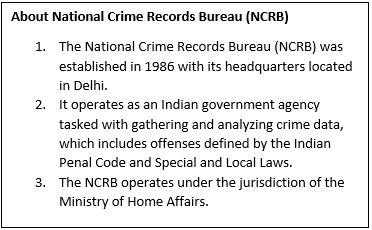- Courses
- GS Full Course 1 Year
- GS Full Course 2 Year
- GS Full Course 3 Year
- GS Full Course Till Selection
- Online Program
- GS Recorded Course
- NCERT (Recorded 500+ Hours)
- Polity Recorded Course
- Geography Recorded Course
- Economy Recorded Course
- AMAC Recorded Course
- Modern India, Post Independence & World History
- Environment Recoded Course
- Governance Recoded Course
- Science & Tech. Recoded Course
- International Relations and Internal Security Recorded Course
- Disaster Management Module Course
- Ethics Recoded Course
- Essay Recoded Course
- Current Affairs Recoded Course
- CSAT
- 5 LAYERED ARJUNA Mentorship
- Public Administration Optional
- ABOUT US
- OUR TOPPERS
- TEST SERIES
- FREE STUDY MATERIAL
- VIDEOS
- CONTACT US
NIA builds its terror database: National Terrorism Data Fusion & Analysis Centre (NTDFAC)
NIA builds its terror database: National Terrorism Data Fusion & Analysis Centre (NTDFAC)
07-02-2024
In Feb 2024, The National Investigation Agency (NIA) launched the National Terrorism Data Fusion & Analysis Centre (NTDFAC) to streamline the collection and compilation of information on terrorists and their associates from diverse sources within India.
The National Investigation Agency (NIA) has for the first time collected details of all terrorists – including those from Indian Mujahideen and Lashkar-e-Taiba as well as Khalistani militant groups – and uploaded them in one common server at its headquarters in Delhi.
About NTDFAC
- NTDFAC is modeled along the lines of the Global Terrorism Database (GTD) of the US.
- It aims to serve as a centralized database and analysis center for terrorism-related information in India.
Key Features of NTDFAC
- Comprehensive Database: Includes case histories, fingerprints, videos, pictures, and social media profiles of individuals involved in terrorist activities.
- Automated Fingerprint Identification System (AFIS):
- Integration with the National Automated Fingerprint Identification System (NAFIS) enables quick and accurate identification of suspects.
- The National Automated Fingerprint Identification System (NAFIS), managed by the National Crime Records Bureau (NCRB), is a nationwide searchable database of crime- and criminal-related fingerprints.
- Face Recognition System: Utilizes facial recognition technology to scan pictures of suspects from CCTV footage for identification and tracking.
- Support for State Police Forces: Provides access to the centralized server for state police forces to gather information on terrorists operating within their jurisdictions.
About NAFIS
Conceptualized and managed by the National Crime Records Bureau (NCRB), NAFIS serves as a central information repository for fingerprint data from all states and Union Territories in India.
Key Features of NAFIS
- Functionality:
- The web-based application acts as a central repository, consolidating fingerprint data from all states and Union Territories.
- According to a 2020 report by the NCRB, it enables law enforcement agencies to upload, trace, and retrieve data in real-time, 24/7.
- Unique Identifier:
-
- NAFIS assigns a unique 10-digit National Fingerprint Number (NFN) to each arrested individual.
- This NFN remains with the person for their lifetime, linking different crimes registered under different FIRs to the same NFN.
-
- Integration with CCTNS:
-
- Through automating the collection, storage, and matching of fingerprints, NAFIS aims to provide a unique identifier for every arrested person in the CCTNS database.
- Both systems are interconnected at the backend, facilitating seamless data exchange.
-
- Real-Time Data Upload and Retrieval: Enables law enforcement agencies to upload, trace, and retrieve fingerprint data in real-time, enhancing efficiency in criminal identification processes.
- Replacement for Previous Systems: NAFIS is the latest version in a series of automated fingerprint identification systems in India, replacing the outdated FACTS 5.0 system.
- The NAFIS Working Process:
- NCRB enables law enforcement agencies to upload, trace, and retrieve data.
- Within 24 hours, NAFIS assigns a unique 10-digit National Fingerprint Number (NFN) to each arrested criminal.
- This ID is used for life, linking different crimes under the same NFN.
- The ID includes the state code and a sequence number.
- Digital records are stored for future fingerprint matching.
- NAFIS enables quick location of individuals and links to warrants and related criminal information.
About National Investigation Agency (NIA)
- The National Investigation Agency (NIA) is a federal agency of the Indian government tasked with investigating and prosecuting crimes related to terrorism, insurgency, and national security.
- It was established in 2009 following the Mumbai terrorist attacks of 2008, under the National Investigation Agency (NIA) Act, 2008, and operates under the Ministry of Home Affairs.
A. Functions of NIA:
- Collecting, analyzing, and disseminating intelligence related to terrorism and national security.
- Coordinating with law enforcement agencies within India and internationally on terrorism and national security matters.
- Its jurisdiction extends to the whole of India and covers Indian citizens outside the country, persons in government service, persons on Indian registered ships and aircraft, and those committing scheduled offenses beyond India.
- Organizing capacity-building programs timely for law enforcement agencies and other stakeholders.
B. Investigation power of NIA
- The NIA can initiate investigations based on referrals from state governments or directives from the Central government.
- It has the authority to investigate cases across state boundaries without prior permission from state governments.
- The NIA seeks sanction from the Central government for prosecuting accused individuals under certain scheduled offenses.
- There is a specialized unit within the NIA dedicated to handling cases related to Left Wing Extremism (LWE) and terror financing.
- The NIA can investigate any other offenses connected to a scheduled offense during its investigation.
- Cases investigated by the NIA are presented before the NIA Special Court for prosecution.
What are scheduled offenses?
- Scheduled Offences refer to a list of specific offenses outlined in the NIA Act, which are subject to investigation and prosecution.
- The scheduled offenses include acts such as those involving terrorism, insurgency, unlawful activities against the sovereignty and integrity of India, and offenses specified under international treaties, conventions, and agreements.
- The NIA has the authority to investigate scheduled offenses not only within India but also outside the country, enabling it to pursue transnational crimes related to terrorism and national security.
- The list includes
- Explosive Substances Act
- Atomic Energy Act
- Unlawful Activities (Prevention) Act
- Anti-Hijacking Act
- Suppression of Unlawful Acts against Safety of Civil Aviation Act
- SAARC Convention (Suppression of Terrorism) Act
- Suppression of Unlawful Acts Against Safety of Maritime Navigation and Fixed Platforms on Continental Shelf Act
- Weapons of Mass Destruction and their Delivery Systems (Prohibition of Unlawful Activities) Act
- Any other relevant offences under the Indian Penal Code, Arms Act and the Information Technology Act.
- Narcotic Drugs and Psychotropic Substances Act



